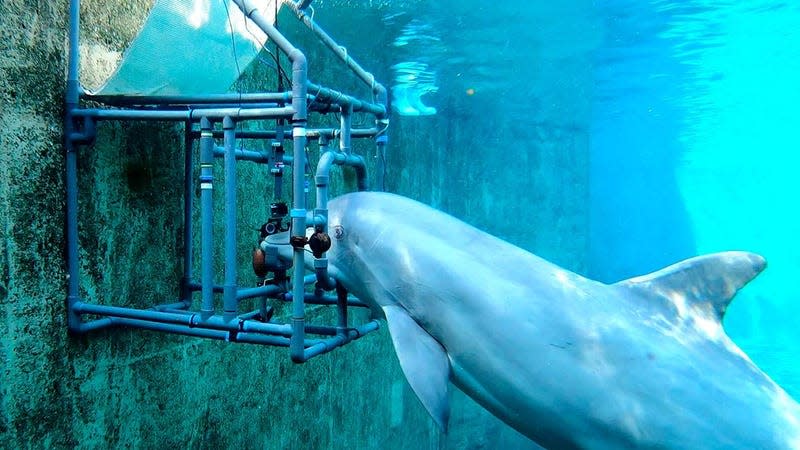Bottlenose Dolphins Somehow Even Cooler Than We Knew, Can Sense Electricity

Dolly the dolphin resting her jaw on a metal bar. The set-up was used to test the dolphin’s sense of electroreception in a series of experiments.
It looks like bottlenose dolphins may have more tricks up their fins than we knew. New research involving trained zoo dolphins seems to confirm that these mammals can sense electricity, much like other aquatic life. The talent may allow them to better hone in on hidden fish prey and navigate using the Earth’s magnetic field, the authors say.
The biological ability to sense electric fields is known as electroreception. All animals produce a weak electric field, but electroreception has almost exclusively been found in aquatic or semi-aquatic life to date. Some fish can even actively generate electricity as a way to stun and locate their food. A wide variety of water-dwelling organisms possess at least a passive sense of electroreception, including sharks, some amphibians, and certain mammals like echidnas.
Read more
PlayStation To Delete A Ton Of TV Shows Users Already Paid For
Baldur’s Gate 3 Patch Now Lets You Recruit Minthara Without Mass Murder
Consumer Reports Says These Are The Most Reliable Cars Of 2024
The findings further validate that bottlenose dolphins can indeed sense electricity, but suggest that some dolphins are better at it than others. Donna, for instance, was a bit more sensitive and able to respond correctly to a weaker field than Dolly. Both dolphins were also worse at detecting pulsing electric fields, though Donna was again better overall.
“One takeaway is that for even such a well-studied animal like the bottlenose dolphin, we were able to show that we still don’t know everything about them yet,” lead author Tim Hüttner told Gizmodo in an email.
The electroreception found in these two dolphin species doesn’t appear to be anywhere as strong as it is in the typical shark, but it’s probably still useful enough for them to find fish hiding underneath sediment within a few centimeters away, the authors say. And the fact that it’s now been found in two species indicates that electroreception could be a common feature in many other dolphins and toothed whales. Other studies have suggested that dolphins also possess a sense of magnetism that acts as a sort of natural GPS for them, though it’s still not clear how this happens. So these dolphins’ electroreception might provide a concrete explanation for that speculated ability as well, Hüttner said.
As for what’s next, the authors would look to see more research testing out the capabilities of this newfound sense, such as how moving dolphins respond to electric stimuli. And it might also be interesting to find out which other small dolphins and toothed whales have electroreception, Hüttner added.
More from Gizmodo
GTA 6's Teaser Image Has Three Birds I Can't Stop Thinking About
Cyberpunk 2077 Gets Working Metro And More In Last Big Update
Consumer Reports Says These Are The Least Reliable Cars For 2024
Sign up for Gizmodo's Newsletter. For the latest news, Facebook, Twitter and Instagram.

